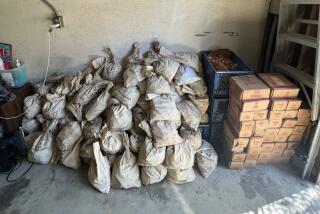Seller’s Knowledge Is Part of the Deal
- Share via
Question: How does an amateur collector go about checking on “reputable” coin dealers? When selling coins, does one know that the quoted prices are fair and accurate?--H.S.K.
Answer: Your twofold question is basic to numismatics and asked more often in one form or another than any other I receive. The most direct and simple answer is that the seller (collector) should know as much as the buyer (dealer) or vice versa if the transaction is going the other way. The key word in buying or selling is knowledge. If you know as much about coins as the dealer, then the dealer will not have an advantage. It’s as simple as that.
Most people are not willing to put the time and effort into collecting that they would put into purchasing a loaf of bread. Some people will comparison shop for relatively minor items and then buy something as major as an automobile on the spur of the moment. Others will research an automobile or major-appliance purchase, look for sales, discuss performance with friends and neighbors. Only after they’re totally satisfied will they buy that refrigerator or microwave oven or VCR.
If the same energy went to purchasing coins, finding so-called “reliable” dealers wouldn’t be a problem. It’s true, some dealers will take advantage of the unwary. But most, however, are simple businessmen who know considerably more than their customers. They work with a bid-ask spread and are in business to make a profit. The better dealers might also make a bigger profit; but they also might do better for their customers. That is because there’s more dealer-to-dealer business than dealer-to-customer. Dealers would rather pit knowledge and experience against another dealer, passing along the resulting good deals to loyal customers.
That’s because a dealer’s lifeblood is buying and selling. It’s much more difficult to buy good material than to sell. If a dealer can place quality pieces with customers who eventually will sell them back, it makes the dealer’s job that much more efficient and benefits all concerned, since, historically, investment-quality coins continue to increase in value as demand outstrips supply.
After gaining the necessary knowledge regarding coin grading and pricing, seek out dealers who are well-established, who have professional affiliations, who offer grading and buy-back guarantees and who conduct themselves in a businesslike manner. Comparison shop dealers the same as you would comparison shop a new car or a diamond ring. The reliable dealer is out there, just waiting to be discovered.
Q: Enclosed is a copy of the front and back of an Arkansas Treasury Warrant dated April 28, 1862. Does this warrant have any value if turned in to the treasury of the state of Arkansas, or would it be of interest to a collector? This document is in excellent condition with no tears, wrinkles or folds. The paper has turned slightly yellow and is darkened around the extreme edges.--A.C.A.
A: Your note does have some collector value, although I doubt that the state of Arkansas would be interested. However, to collectors, your note could be worth $150, if it is still crisp. Show it to some paper money specialists for an appraisal.
Q: As you see from the photocopy, I have a $1,000 note, No. 8894, issued by the Bank of the United States, with date of Dec. 15, 1840, and with promise to pay 17 months after that date the face amount in New York. This is a parchment and not the usual paper note and is in perfect condition. There is no imprinting on the reverse.--H.N.K.
A: From your description, your note appears to be a copy or replica, in which case it would have no collector value. If genuine, such notes still only have a retail value of about $4 or $5.
Q: I recently came across a coin I’m puzzled by. It is penny-size, apparently copper. One side has the words: “Army and Navy” with an anchor. The opposite side says: “The Federal Union, It Must and Shall Be Preserved.” There is no date or other inscription on the coin.--C.T.
A: What you have is a token, not a coin. There are collectors for such pieces. It’s worth $1.50 and up.
Q: I have a set commemorating the 1,100th anniversary of the settlement of Iceland, 874-1974, in proof condition. It consists of three coins; two are silver and the third one, the 10,000 kroner, is gold. This set was minted by the Bank of England. What is the value?--G.W.K.
A: Your Iceland commemorative set has a catalogue value of $270. A dealer would pay you considerably less.
Coin Update
Concerning the June 18 question regarding the 1978 aluminum cent: As I stated, none were minted, but Sol Taylor adds this footnote: “The U.S. Mint was authorized to strike a small number of aluminum cents in 1974. About 30 specimens were presented to the Assay Commission meeting in Philadelphia early in the year. Another group of aluminum cents was presented for comment to selected members of the House Banking Committee. Later in the year a story broke that a few (perhaps four or five) of those aluminum cents were unaccounted for. None has been found. I think the U.S. Mint has one and perhaps the Smithsonian has one, but as far as anyone can tell, no others exist.”
More to Read
Inside the business of entertainment
The Wide Shot brings you news, analysis and insights on everything from streaming wars to production — and what it all means for the future.
You may occasionally receive promotional content from the Los Angeles Times.










